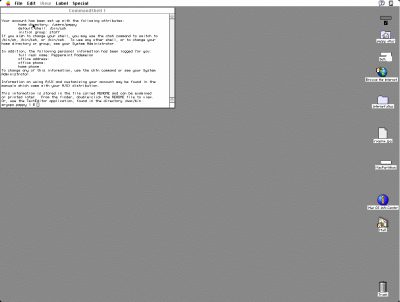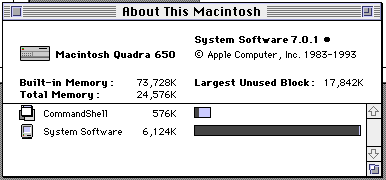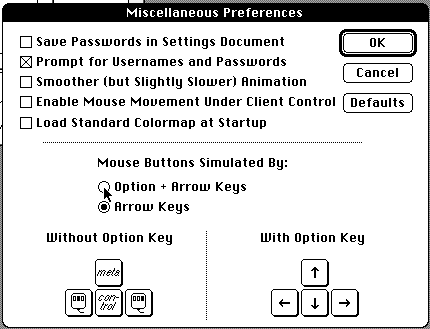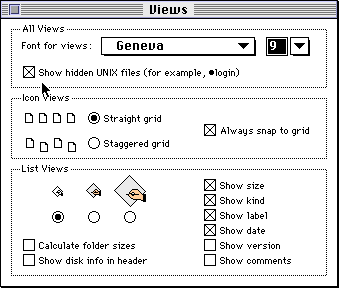|
|
Location: GUIs >
Apple >
Apple A/UXA/UX: First Impressions:Okay, I'm going to skip over all the grim details of installing A/UX and configuring it to work. This is primarily just a sightseeing tour, not a how-to on running A/UX. All I'll say on the matter is that installing it is somewhat similar to installing OS X on a new Mac, except that partitioning the hard disk isn't an optional step. A/UX requires a real UNIX file system, and won't run on top of HFS. (Which is actually a good thing, but I won't get into that.)For purposes of illustration, we're going to pretend that you've already gotten everything set up, including configuring the kernel for Ethernet and TCP/IP, and just created a user account so you're not logging in as root constantly. (If you're not familiar with UNIX concepts like 'root', then don't worry about it. I'm just showing you around; there's no test at the end.) Here's what we see after we log in to a default 32 bit Finder session and open the CommandShell for the first time:  (bull****. Yes, I was in a foul mood when I named that partition. It's a relic from when the drive was installed in a Power Mac 7200. A machine that firmly instilled a cordial hatred for beige Power Macs into my soul. Anyway, enough of that. I edited the screenshots to keep them Family Oriented and all.) You may have noticed the other drive, 'MacPartition'. That's a small 3MB-sh System 7 partition that A/UX uses at startup. If you've ever used one of the other Macintosh *nix'es, particularly MkLinux and older versions of LinuxPPC, you may remember the 'BootX' program which jumpstarts the other OS by using Mac OS to load the kernel and start it executing. A/UX does something similar.   If you're not familiar with X Windows at all, just follow along. I'll explain a bit about how it works on the next page. Some aspects of it might seem a bit alien to someone used to the GUIs that come on consumer-oriented machines.  As an aside, there are a few wrinkles you do have to watch out for. Mac files are stored on the UNIX file system in a format called 'AppleSingle', which means that the resource and data forks are merged together. The Finder transparently translates for Macintosh programs, but some issues come up if you use a Mac program to save a UNIX file. The header information added by the AppleSingle format corrupts the file so far as UNIX is concerned. The workaround is to use the 'fcnvt' program to convert the file to 'AppleDouble' format, which separates the resource and data forks into two files. I have to say this is a wee bit kludgey. If you use the Netatalk Appletalk server daemon for UNIX to store Apple files, for instance, it uses the AppleDouble format by default; automatically storing the data fork where the user drops the file and storing the resource fork in a hidden directory. This allows UNIX programs to use the file without any conversion step. Interestingly enough, the A/UX FAQ implies that it's possible to change the default storage format used by the Finder to AppleDouble. In theory at least that might simplify life somewhat if you require a lot of UNIX/Macintosh co-editing of the same files. It would clutter up your drive a bit in exchange, of course. |